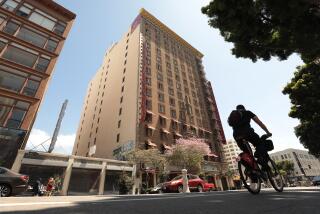Lack of Buyer Forces Griswold’s to File Chapter 11 Bankruptcy : Hotels: Proprietors will reorganize while continuing to search for new owners. The local landmark will remain open in the meantime.
CLAREMONT — A partnership that controls Griswold’s Inn has filed for federal bankruptcy protection while a buyer is sought for the venerable Claremont hotel and restaurant complex.
Alton (Sandy) Sanford, who has owned Griswold’s for four decades, said efforts to cut expenses in order to fatten the bottom line failed to attract potential buyers, and the mortgage holders have threatened to foreclose.
So last week, Foothill Inn, a partnership headed by Sanford, filed for Chapter 11 protection, a process Sanford hopes will give him time to reorganize the operation while continuing to seek a buyer.
The partnership owns the hotel and other buildings at the 12-acre Griswold’s complex and controls the site through a long-term lease on 4.9 acres and outright ownership of the remainder of the land.
A separate operating company that manages the complex is not in bankruptcy, Sanford said. He emphasized that the hotel, restaurants and dinner theater will remain open.
Ever the optimist, Sanford said he has talked to five potential buyers and hopes to have a deal within a month. He would renovate the hotel himself, he said, but he cannot obtain financing. Besides, he wants out.
“I’m 77 years old,” he said. “I should have retired 10 years ago, at least.”
Despite its decline, Griswold’s remains a Claremont institution, noted for its well-landscaped grounds, Candlelight Pavilion dinner theater, weekend art fairs and smorgasbord restaurant.
“Most everybody thinks of it as an important part of Claremont,” Mayor Diann Ring said.
Like the Claremont Colleges and the downtown Village, she said, Griswold’s is what comes to mind when people define the city.
And at least until the 1980s, Ring said, Sanford and his wife, Betty, were Claremont’s great entrepreneurial success story, taking a fruit stand and building it into a hugely successful business.
The roots of the hotel complex go back to 1909, when a local college professor, George Carter Griswold, started selling orange marmalade by mail order out of his home. He built a factory in 1915 to make candied fruit and preserves, and opened a stand that quickly attracted tourists.
Sanford said that when he and his wife bought the business in 1950, much of the trade continued to come from tourists, many of whom took a bus tour from the Mission Inn in Riverside that included stops at a winery, an orange packing house and Griswold’s.
“We’d serve them fresh orange juice, samples of our candied fruit, and get them on a mailing list and then send them a catalogue for Christmas,” Sanford said.
The couple added a bakery and the smorgasbord, and by 1960 they had so much business that they needed a new building. They moved to the current site on Foothill Boulevard, west of Indian Hill Boulevard.
The hotel was added in 1968. The old Claremont High School was acquired in 1970 and converted into shops. The Candlelight Pavilion dinner theater was opened, in partnership with Ben Bollinger, in 1985.
Meanwhile, the Sanfords opened another smorgasbord restaurant in Redlands, which continues in operation, and a hotel in Fullerton, which they later sold.
At the beginning of the 1980s, Sanford said, he turned over the business to his son, but that arrangement did not work out.
By the mid-1980s, Sanford was back in charge. But by that time, competition from new hotels built near Ontario International Airport, was beginning to hurt. The occupancy rate at Griswold’s had slumped from an average of 70% to under 40% by 1986. The hotel began cutting back on services.
Sanford eventually put the hotel on the market for $8 million. One developer tied up the property for 18 months with an option but could not get financing; others came close to buying it, but didn’t, he said.
As the years passed, the skimping on maintenance began to show, driving away hotel and restaurant customers. So three months ago, the strategy shifted. The sales staff was slashed so that more money could be spent on maintenance; lists of deficiencies were compiled and acted upon, and a system was installed to verify that guest complaints were handled properly.
A recovery appeared to be under way in 1989 and 1990, Sanford said, but then the recession and the Gulf War reduced travel. In June, 1991, Griswold’s stopped making payments on the $5-million-plus mortgage, which led to a threatened foreclosure and, finally, to the bankruptcy filing.
Meanwhile, with the deferral of maintenance--although it is still a three-star hotel in the current Mobil travel guide--Griswold’s reputation began to suffer.
Nancy Tresser-Osgood, associate director of alumni relations at Pomona College, said the college last year started sending alumni to the Ontario Hilton 10 miles away instead of to Griswold’s, only a few blocks away.
There were complaints of toilets not working, water coming out of the ceiling lights and other problems, Tresser-Osgood explained. She said about half the rooms were considered good and half were not, making it difficult to recommend. But, she said, the college will take its account back to Griswold’s once it is certain that needed improvements have been made.
“If they turn the place around, by all means we’re going back,” she said.
Sanford said some customers who went elsewhere have already returned on the strength of renewed efforts to improve facilities and service.
“We’re working hard to get back,” he said.
Griswold’s is facing tough competition--including the new Sheraton Suites Fairplex at the Los Angeles County fairgrounds in Pomona--with several advantages, Sanford maintains, including an environment that is more pleasant than a freeway or airport location, and comparatively low room rates, averaging $50 a night.
Sanford said he has reduced the asking price of the hotel, which sits on 8 1/2 acres, to $6.8 million. He said his neighboring property of 2.7 acres, which includes the Candlelight Pavilion, is also on the market, reduced from $3.5 million to $2.5 million.
Parts of the business have continued to prosper, Sanford said. The dinner theater is doing well, a new Mystery Theater is drawing near-capacity crowds, and the smorgasbord has a loyal clientele. But the hotel’s occupancy rate is below 50%, he said. The hotel could pay its bills at 60% occupancy and be highly profitable at 70%, he said. And with an investment of $2 million in improvements, he said, the business should prosper.
“It’s a beautiful property,” Sanford said. “It’s the kind of thing where if the buyer spends the money to renovate the rooms and the public spaces, he would have far greater value than if he spent the same amount on any other hotel.
“There is so much potential here.”
Meanwhile, Sanford fears that news about the Chapter 11 filing might further depress the business. And he worries that the mortgage holders--Cigna Insurance Co. and Foothill Independent Bank--might try to force him out through the bankruptcy proceedings.
“It’s been a little bit stressful,” the hotelier said. But, he quickly added, that he is confident buyers will be found. Sanford said he is asking “not an exorbitant price and not a depressed price, but a fair price” for a business he has held for more than 40 years. “We’ve had a good run,” he said.
More to Read
Inside the business of entertainment
The Wide Shot brings you news, analysis and insights on everything from streaming wars to production — and what it all means for the future.
You may occasionally receive promotional content from the Los Angeles Times.










